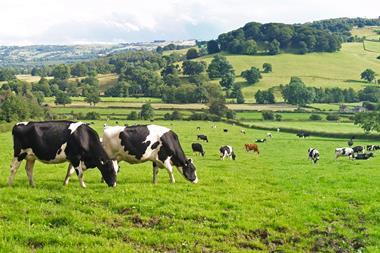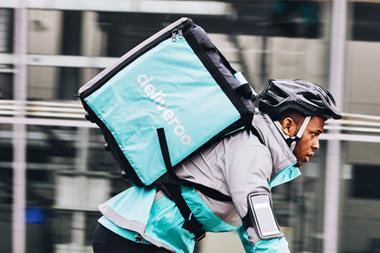Unflattering comparatives revealed by The Grocer show that Sainsbury's has a tough task ahead to continue its recovery after the Delta Two débâcle, says Mark Choueke
Doing nothing is no longer an option”. That was the warning Deutsche Bank analyst James Collins gave the Sainsbury's board back in July when Qatar-based investment firm Delta Two tabled an offer.
Four months later and with negotiations over a £10.6bn takeover having collapsed, Collins may offer the same advice again. Delta Two's approach was the second failed private equity play for the retailer this year following the attempt of a CVC Capital Partners-led consortium to take it private in April
The board, which was understood to be keen on the Delta Two deal, will join the City in wondering what happens next. The stock clearly looks attractive to buyout groups on first sight but the City is divided over the possibility of a third attempt to take the chain private. Whether or not this happens, the successful recovery of Sainsbury's depends on addressing unflattering comparatives, as revealed by The Grocer's analysis (see box). An alarming leakage of money in the past may explain why Sainsbury's has drawn so many suitors from private equity.
Three years into chief executive Justin King's recovery plan, the new mantra at Sainsbury's is From Recovery to Growth. King's Making Sainsbury's Great Again plan was due to be completed by March 2008. But a new set of three-year targets has already been drawn up to achieve by 2010. King wants a programme of expansion: 30 new supermarkets, 100 Local stores and 75 store extensions will add 10% to the current retail floorspace and total 19 million sq ft.
The Grocer has found, however, that in the past five years Sainsbury's spent £621 per sq ft on new land and buildings compared with Tesco's £406. And though Sainsbury's has managed to bring its costs down for the forthcoming programme of store growth, it will still pay £614 per sq ft. One analyst described this as “bubble” economics. Sainsbury's puts the unflattering numbers down to the fact costs are higher in the south east where many of its stores are.
In addition, Sainsbury's store management model means each new store has a three-year gestation period of maturing to full profitability. But although, like Tesco, Sainsbury's makes new stores fully profitable within the same period, Tesco gains full value from each outlet much faster: a Tesco store typically achieves 70% sales maturity one year after opening compared with 60% over the same period for a Sainsbury's.
City sources say Sainsbury's has never got its labour planning model right in terms of store management. Tesco employs more staff - 280,000 - than Sainsbury's, which has a headcount of 150,000. But Tesco puts many employees on shorter contracts, giving it flexibility around the country. To utilise manpower exactly where it is needed most, Tesco measures the needs and staff requirements of the business constantly, store-by-store and hour-by-hour. Tesco's multifunctional staff are all till-trained to ensure they can always be busy, while Sainsbury's structure incorporates more hierarchy.
One source says: “There are far too many people working for Sainsbury's who aren't doing any work. It's a problem at many organisations but Sainsbury's has turned it into an art form.”
With a pre-tax profit of £477m for the year to March 2007, Sainsbury's business works out at £3,180 profit per worker. Asda, which employs 161,000, manages to extract £3,677 for each employee. Both trail in comparison to Tesco, which creates £6,785 of profit for every one of its 280,000 staff.
Sainsbury's appears to have recognised the deficit and recently launched a new centrally run store manning system, though it will be installed only in supermarkets.
There are other cost savings to be made. Longstanding product availability issues have not been fully resolved; indeed it appears the problem has swung the other way. In its preliminary results announcement in May, the board admitted it was lagging behind its own targets in terms of reducing stock loss, and that “further shrinkage remains an opportunity”.
When it comes to buying and ordering stock, a senior retail executive says: “Tesco is massively more efficient than Sainsbury's. The forecasting tools it uses are better and it understands them item-by-item.” Tesco uses a management system called Galleria and, tellingly, Asda plans to switch to the same system in 2008.
With such inefficiencies built into Sainsbury's cost base, sales growth has been achieved but only at the expense of margins: 2.5% compared with 5% at Tesco. One retail source notes “there are structural constraints that put a ceiling of 4% on margins including the depreciation it's still having to pay on massive investment in IT”.
Another retail source estimates that Sainsbury's current efforts to develop its non-food, so as to provide one third of new sales growth, is only likely to contribute 0.5% margin improvement at most.
To its credit Sainsbury's has recognised the flab on its business model and has an ongoing plan to offset 50% of its operation cost inflation. Part of that drive involved moving the HQ to Kings Cross from expensive Holborn. The 2010 move will save some £7m in overheads per year. King is understood to want to make a further £60m annual saving from central office but analysts are asking whether more savings couldn't have been made by moving from the capital.
With so many potential cost cuts and heightened returns, why have two private equity buyers bailed out at the last minute?
While the credit crunch has been blamed for the latest retreat, making the numbers work is not easy. A senior retail source claims Sainsbury's attempt to unlock value from its property portfolio, valued at more than £8bn in recent negotiations, “may not add much to margins after paying more rent than it already does”. The source adds that Sainsbury's pays 25% of its pre-rent profit whereas Tesco, tied up in a joint venture with British Land, pays virtually nil.
When venture capital comes in, it starts cost-cutting. But when you concentrate on a quality food offer, you inevitably concede something on price. It takes a higher cost base and manpower to deliver that sort of strategy. Sainsbury's has 200 people in product development - twice the relative size of Tesco's team. Where does King go from here? Doubtless he will tell analysts he is getting on with the business of making Sainsbury's great again, but it won't be easy.
He needs to listen to James Collins, shut the boardroom door and make a lot more changes.
Doing nothing is no longer an option”. That was the warning Deutsche Bank analyst James Collins gave the Sainsbury's board back in July when Qatar-based investment firm Delta Two tabled an offer.
Four months later and with negotiations over a £10.6bn takeover having collapsed, Collins may offer the same advice again. Delta Two's approach was the second failed private equity play for the retailer this year following the attempt of a CVC Capital Partners-led consortium to take it private in April
The board, which was understood to be keen on the Delta Two deal, will join the City in wondering what happens next. The stock clearly looks attractive to buyout groups on first sight but the City is divided over the possibility of a third attempt to take the chain private. Whether or not this happens, the successful recovery of Sainsbury's depends on addressing unflattering comparatives, as revealed by The Grocer's analysis (see box). An alarming leakage of money in the past may explain why Sainsbury's has drawn so many suitors from private equity.
Three years into chief executive Justin King's recovery plan, the new mantra at Sainsbury's is From Recovery to Growth. King's Making Sainsbury's Great Again plan was due to be completed by March 2008. But a new set of three-year targets has already been drawn up to achieve by 2010. King wants a programme of expansion: 30 new supermarkets, 100 Local stores and 75 store extensions will add 10% to the current retail floorspace and total 19 million sq ft.
The Grocer has found, however, that in the past five years Sainsbury's spent £621 per sq ft on new land and buildings compared with Tesco's £406. And though Sainsbury's has managed to bring its costs down for the forthcoming programme of store growth, it will still pay £614 per sq ft. One analyst described this as “bubble” economics. Sainsbury's puts the unflattering numbers down to the fact costs are higher in the south east where many of its stores are.
In addition, Sainsbury's store management model means each new store has a three-year gestation period of maturing to full profitability. But although, like Tesco, Sainsbury's makes new stores fully profitable within the same period, Tesco gains full value from each outlet much faster: a Tesco store typically achieves 70% sales maturity one year after opening compared with 60% over the same period for a Sainsbury's.
City sources say Sainsbury's has never got its labour planning model right in terms of store management. Tesco employs more staff - 280,000 - than Sainsbury's, which has a headcount of 150,000. But Tesco puts many employees on shorter contracts, giving it flexibility around the country. To utilise manpower exactly where it is needed most, Tesco measures the needs and staff requirements of the business constantly, store-by-store and hour-by-hour. Tesco's multifunctional staff are all till-trained to ensure they can always be busy, while Sainsbury's structure incorporates more hierarchy.
One source says: “There are far too many people working for Sainsbury's who aren't doing any work. It's a problem at many organisations but Sainsbury's has turned it into an art form.”
With a pre-tax profit of £477m for the year to March 2007, Sainsbury's business works out at £3,180 profit per worker. Asda, which employs 161,000, manages to extract £3,677 for each employee. Both trail in comparison to Tesco, which creates £6,785 of profit for every one of its 280,000 staff.
Sainsbury's appears to have recognised the deficit and recently launched a new centrally run store manning system, though it will be installed only in supermarkets.
There are other cost savings to be made. Longstanding product availability issues have not been fully resolved; indeed it appears the problem has swung the other way. In its preliminary results announcement in May, the board admitted it was lagging behind its own targets in terms of reducing stock loss, and that “further shrinkage remains an opportunity”.
When it comes to buying and ordering stock, a senior retail executive says: “Tesco is massively more efficient than Sainsbury's. The forecasting tools it uses are better and it understands them item-by-item.” Tesco uses a management system called Galleria and, tellingly, Asda plans to switch to the same system in 2008.
With such inefficiencies built into Sainsbury's cost base, sales growth has been achieved but only at the expense of margins: 2.5% compared with 5% at Tesco. One retail source notes “there are structural constraints that put a ceiling of 4% on margins including the depreciation it's still having to pay on massive investment in IT”.
Another retail source estimates that Sainsbury's current efforts to develop its non-food, so as to provide one third of new sales growth, is only likely to contribute 0.5% margin improvement at most.
To its credit Sainsbury's has recognised the flab on its business model and has an ongoing plan to offset 50% of its operation cost inflation. Part of that drive involved moving the HQ to Kings Cross from expensive Holborn. The 2010 move will save some £7m in overheads per year. King is understood to want to make a further £60m annual saving from central office but analysts are asking whether more savings couldn't have been made by moving from the capital.
With so many potential cost cuts and heightened returns, why have two private equity buyers bailed out at the last minute?
While the credit crunch has been blamed for the latest retreat, making the numbers work is not easy. A senior retail source claims Sainsbury's attempt to unlock value from its property portfolio, valued at more than £8bn in recent negotiations, “may not add much to margins after paying more rent than it already does”. The source adds that Sainsbury's pays 25% of its pre-rent profit whereas Tesco, tied up in a joint venture with British Land, pays virtually nil.
When venture capital comes in, it starts cost-cutting. But when you concentrate on a quality food offer, you inevitably concede something on price. It takes a higher cost base and manpower to deliver that sort of strategy. Sainsbury's has 200 people in product development - twice the relative size of Tesco's team. Where does King go from here? Doubtless he will tell analysts he is getting on with the business of making Sainsbury's great again, but it won't be easy.
He needs to listen to James Collins, shut the boardroom door and make a lot more changes.


















No comments yet